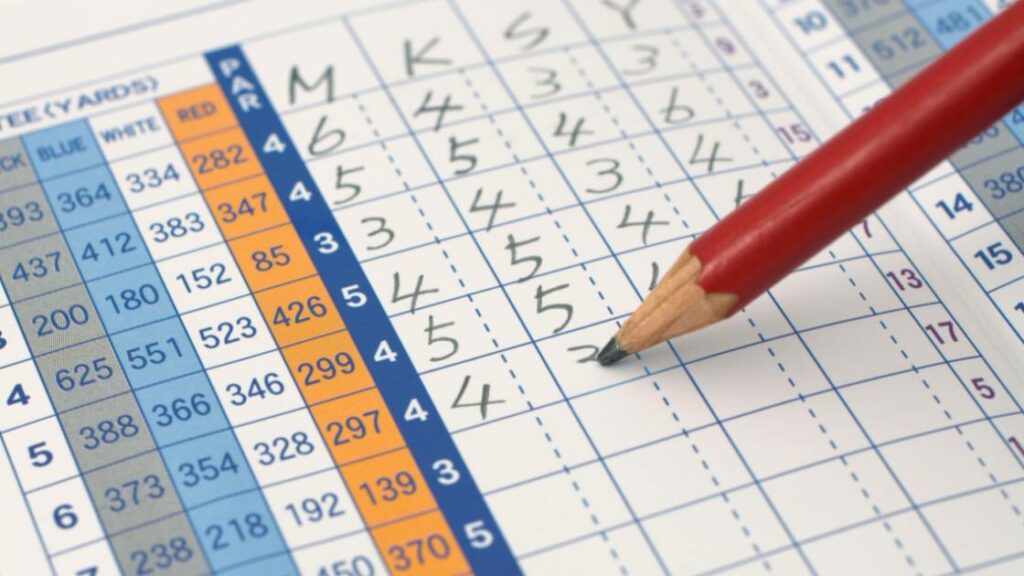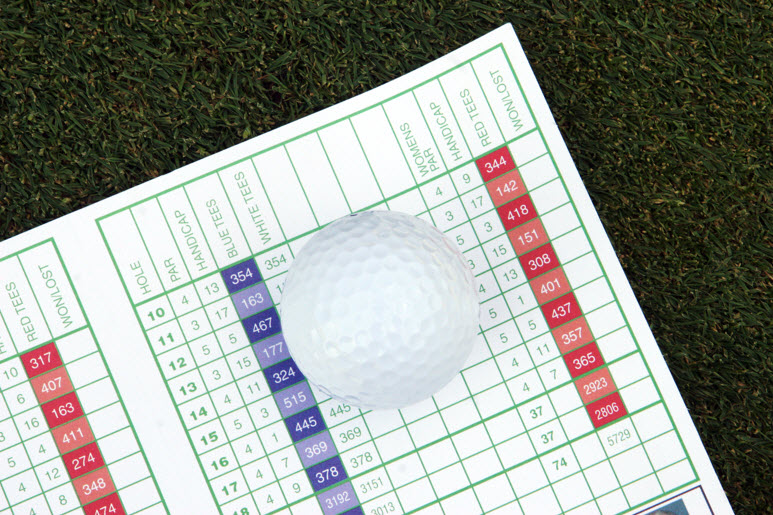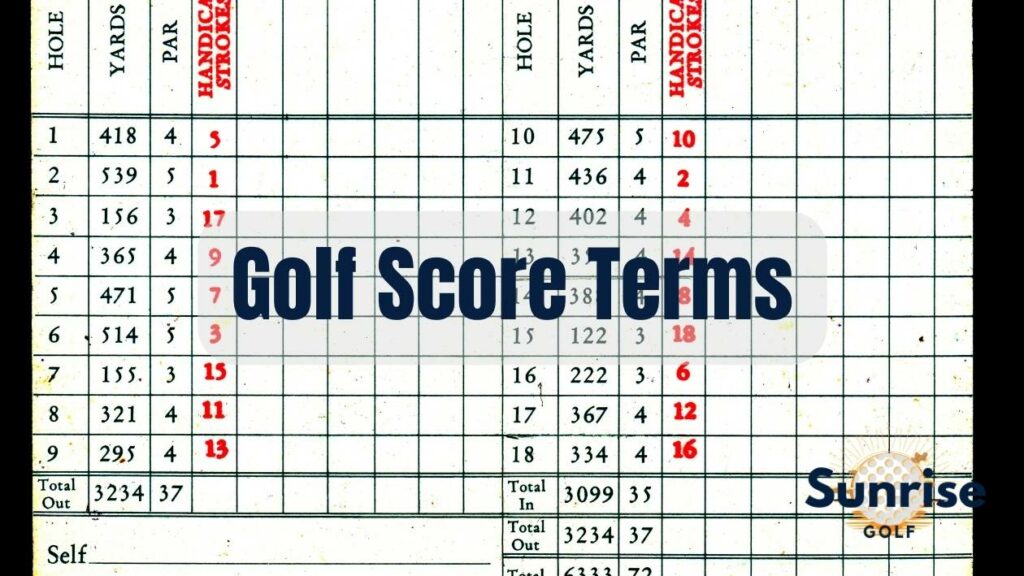Hey there, fellow golf enthusiasts! If you’ve ever swung a club or watched the pros work their magic, you know that golf isn’t just about hitting a ball into a hole. It’s a game of finesse, strategy, and oh, those tricky numbers on the scorecard.
So, let’s kick back and unravel the mystery behind Golf Score Terms like “birdie,” “eagle,” and even the rare “albatross.”
Golf Score Terms
By the end of this ride, you’ll be ready to chat like a seasoned golfer, whether you’re on the fairway or just watching the action unfold on TV.
| Golf Scoring Term | Unlocking the Meaning |
|---|---|
| Stroke | Every forward club swing aiming to hit the ball. |
| Par | The strokes an expert player should complete a hole in. |
| Birdie | Scoring one stroke under par on a single hole. |
| Eagle | Achieving two strokes under par on a single hole. |
| Albatross / Double Eagle | Hitting three strokes under par on a single hole. |
| Condor | Scoring four strokes under par on a single hole. |
| Ace / Hole-in-One | Sinking the ball in one stroke. |
| Bogey | One stroke over par on a single hole. |
| Double Bogey | Two strokes over par on a single hole. |
| Triple Bogey | Three strokes over par on a single hole. |
| Quadruple Bogey | Four strokes over par on a single hole. |

Ever wondered why golfers use terms like birdie, eagle, and albatross?
Do you find yourself puzzled by the difference between par, bogey, and double bogey?
Golf score terms can be quite intriguing, especially for those new to the sport. Understanding these terms is essential for mastering the game, enhancing your golfing experience, and conversing with fellow players.
In this blog post, we’ll delve into the language of golf, exploring the various golf score terms and their meanings.
From the significance of par and bogey to the rare and exciting hole-in-one, you’ll discover how these terms shape the world of golf and reflect players’ achievements on the course.
Mastering Golf Score Terms
To truly appreciate the nuances of golf, it’s important to understand the golf scoring terms that define a player’s performance. Each term corresponds to a specific number of strokes taken on an individual golf hole, with some terms representing desirable outcomes and others indicating room for improvement. Familiarizing yourself with these terms will not only enhance your knowledge of the sport but also allow you to participate in conversations with fellow golfers and accurately track your progress on the course.
Let’s dive into the world of par, bogey, birdie, and beyond, unraveling the meaning behind each term and exploring their significance in the game of golf.
Just What The Heck IS Par?
Par is the cornerstone of golf scoring, serving as the standard number of strokes assigned to each hole based on its length and difficulty.
In other words, par is the number of strokes an expert golfer is expected to take to complete a hole, from tee to cup.
A par score signifies that a golfer has played the hole up to the standard set by the United States Golf Association (USGA) for that particular hole, which can vary from course to course. By achieving strokes on a par, golfers demonstrate their skill in meeting the expectations set by the USGA.
The difference between gross par and net par lies in the consideration of a player’s handicap.
Gross par is the raw score on a hole without factoring in any handicap allowances, whereas net par takes the player’s handicap into account, resulting in fewer strokes on the scorecard.
This system allows golfers of different skill levels to compete fairly against one another.
Bogey and Beyond
While par is the benchmark for golfers, scores that exceed par are considered undesirable and are known as bogeys.
A bogey occurs when a golfer takes one stroke more than par to complete a hole, while a double bogey and a triple bogey represent two and three strokes over par, respectively.
These terms originated from a song called “The Bogey Man” in the early 1890s, which depicted a mysterious figure lurking in the shadows. Golfers at the time equated the elusive Bogey Man with the quest for the perfect score, and the term “bogey score” soon came to represent the ideal score a good player could achieve under perfect conditions.
The further a golfer’s score deviates from par, the more strokes are added to their overall score, making bogeys, double bogeys, and triple bogeys undesirable outcomes.
To improve their performance, golfers should strive to minimize these occurrences and aim for par or better on each hole.
Birdie, Eagle, Albatross, and Condor: The Under-Par Club
On the other end of the spectrum, scores that fall below par are considered impressive achievements in the world of golf. Here are some terms used to describe scores below par.
- Birdie: one stroke under par
- Eagle: two strokes under par
- Albatross (also known as a double eagle): three strokes under par
- Condor: four strokes under par on a single hole
The use of bird names for these terms is thought to signify excellence in performance, as birds were often associated with grace, beauty, and exceptional skill.
Achieving a birdie, eagle, albatross, or the elusive condor is a mark of distinction in golf, as these scores represent exceptional play and are highly sought after by both amateur and professional golfers. The rarity of these achievements only adds to their allure, making them a celebrated aspect of the sport.
Scoring Systems in Golf: Stroke Play, Match Play, and Stableford
While understanding individual scoring terms is crucial, it’s also important to be familiar with the different scoring systems used in golf.
The three main scoring systems are stroke play, match play, and Stableford.
Stroke play is the most common format, where every shot counts, and the total number of strokes taken is tallied to determine the winner. This system is used most often on the PGA Tour and in golf tournaments worldwide.
Match play, on the other hand, focuses on individual holes, with the player scoring the lowest on each hole winning a point. If players tie on a hole, their overall scores remain unchanged.
Stableford is a points-based system in which golfers are awarded points depending on their performance relative to par. This system encourages aggressive play, as the potential reward for an exceptional hole outweighs the risk of a poor performance.
Hole-in-One: The Ultimate Golf Achievement

A hole-in-one, or ace, is the pinnacle of golfing achievements.
This rare and exciting feat occurs when a golfer sinks the golf ball into the hole with just one stroke, typically on par-3 golf holes.
The odds of an average golfer achieving a hole-in-one are 12,000 to 1, making this accomplishment a true cause for celebration.
Upon achieving a hole-in-one, it’s customary for another golfer to witness the event for it to be considered valid.
The golfer who scores the ace will typically keep their scorecard, have it signed by the witness, and save the ball with a note documenting the moment.
Following the round at the Golf Club, the lucky golfer often shares the news with their fellow golfers in the clubhouse and may buy a round of drinks to celebrate the occasion.
Golf Course Ratings and Handicaps
Golf course ratings and handicaps play an essential role in leveling the playing field among golfers of different skill levels.
- A golf handicap is calculated based on a golfer’s performance across multiple rounds of play, with the difference between their average score and the course par determining their handicap. This system allows less experienced golfers to compete fairly against more skilled players by effectively equalizing their scores.
- Course ratings, on the other hand, provide a measure of a golf course’s difficulty, allowing golfers to assess their performance relative to the challenges posed by a specific course.
By understanding course ratings and handicaps, golfers can gain a more accurate picture of their abilities and track their progress as they strive to improve their game.
Tips for Improving Your Golf Score
To elevate your golf game and bring your scores closer to par or better, it’s essential to practice regularly and focus on key areas of improvement.
One valuable tip is to concentrate on your short game within 100 yards, as this can significantly impact your overall score.
To enhance your short game, practice chipping and putting, prioritize accuracy over distance, and ensure you’re using the right club for each shot.
Additionally, developing a consistent pre-shot routine can help you stay focused and maintain a steady rhythm on the course.
Visualize the shot, take a few practice swings, and establish a stable stance before every shot. By committing to each stroke and giving it your all, you’ll see improvements in both your scores and your overall enjoyment of the game.
Golf Scorecard Essentials

A golf scorecard is an indispensable tool for tracking your performance on the course.
Understanding its layout and markings will enable you to accurately record your scores and monitor your progress over time.
A typical golf scorecard includes:
- Course name
- Date
- Player’s name
- Par for each hole
- Space to record the score for each hole
To ensure accuracy, it’s crucial to record your score for each hole, along with any penalty strokes incurred.
By diligently maintaining your scorecard, you’ll gain valuable insights into your strengths and weaknesses on the course, providing a solid foundation for improvement and growth in your golf game.
Golf Etiquette and Scoring
Golf etiquette and scoring go hand in hand, as proper conduct on the course encompasses not only accurate score recording but also maintaining a steady pace of play and respecting fellow golfers.
By adhering to the customs and traditions of the sport, golfers contribute to a positive atmosphere on the course and ensure a fair and enjoyable experience for all participants.
Some key aspects of golf etiquette on golf courses include:
- Arriving early for your tee time
- Following cart path regulations
- Staying quiet when others are taking their shots
- Keeping up with the group ahead of you
By observing these guidelines and accurately recording your golf scores, you’ll demonstrate respect for the game and uphold the values that make golf such a beloved pastime.
Final Thoughts
Throughout this blog post, we’ve explored the fascinating world of golf scoring terms and their significance in the game. From the benchmark of par to the rare and exciting hole-in-one, these terms provide a rich vocabulary for describing a golfer’s performance on the course. By understanding golf course ratings, handicaps, and various scoring systems, we can better appreciate the complexity and nuance of the sport.
As you continue your golfing journey, remember that consistent practice, a focused mindset, and adherence to proper etiquette are the keys to improving your scores and enjoying the game to its fullest. Armed with your newfound knowledge of golf scoring terms, you’re now ready to take on the course and elevate your game to new heights.

